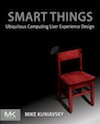Computational objects with information shadows
In a post on Boing Boing, he delves into the topic of designing computational objects.
“Mainstream ubicomp is coming back. The success of Internet services on mobile phones demonstrates that networked products can stretch beyond a laptop browser. The prices for CPUs have fallen below a threshold where incorporating them becomes a competitively viable business decision. Research labs have developed new technologies for embedding information processing in virtually anything. New businesses, such as FitBit, and Green Goose are based on the fact that processing is cheap, and you can include it in anything.
The idea of a single general-purpose “computation” device is fading into the same historical background as having a single steam engine to power a whole factory, or a single electric motor to power every appliance in a house. As it fades, designers and developers have to learn to design smart things that serve the interests, abilities, and needs of people. We must create a practice of ubiquitous computing user experience design.”
Dave Gray, who collaborates with Peter Morville on the Ubicomp Sketchbook, discusses the information shadow concept Kuniavsky introduced, and links it to Bruce Sterling‘s spime concept.
“The information shadow is the information that’s associated with an object such as its name, number, position in space and time, and so on. […] Information shadows allow designers to make objects simpler, to reduce the size of interfaces and reduce the display requirements of an object.”




